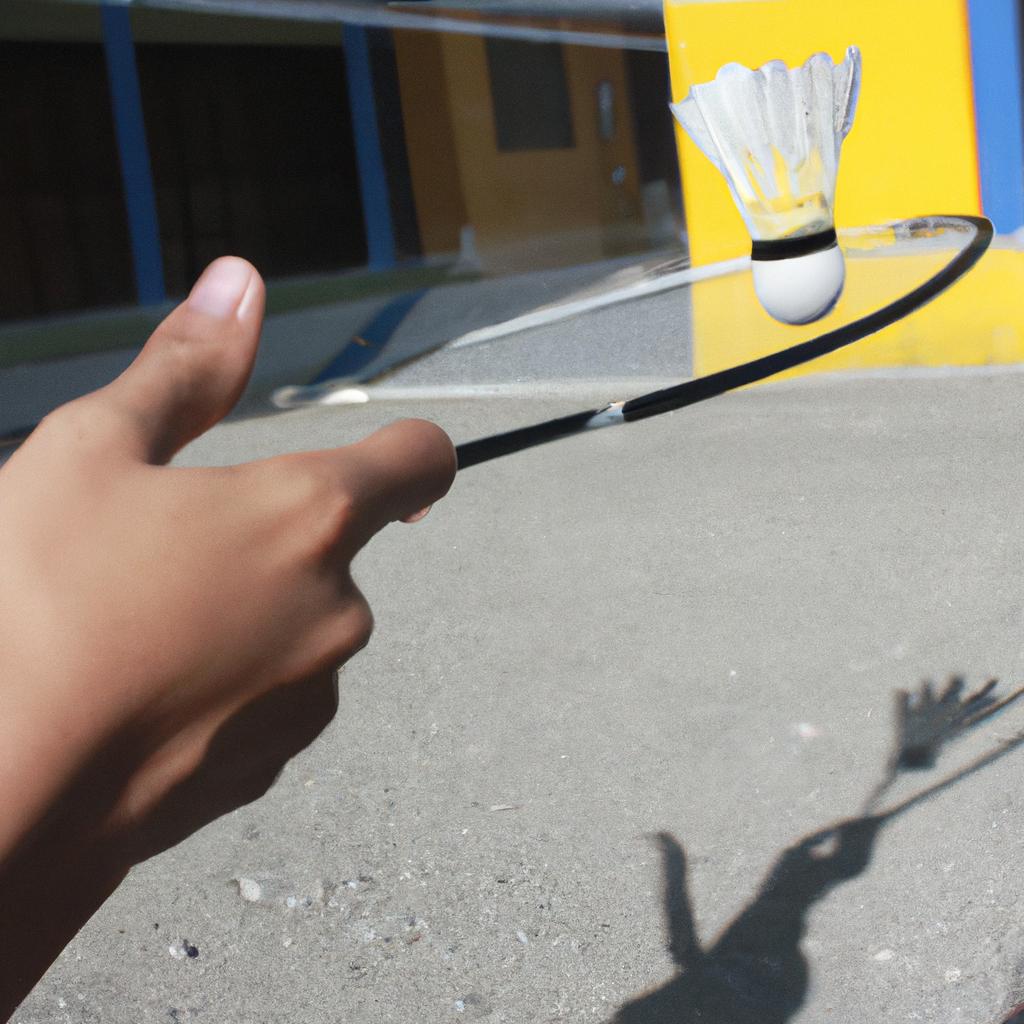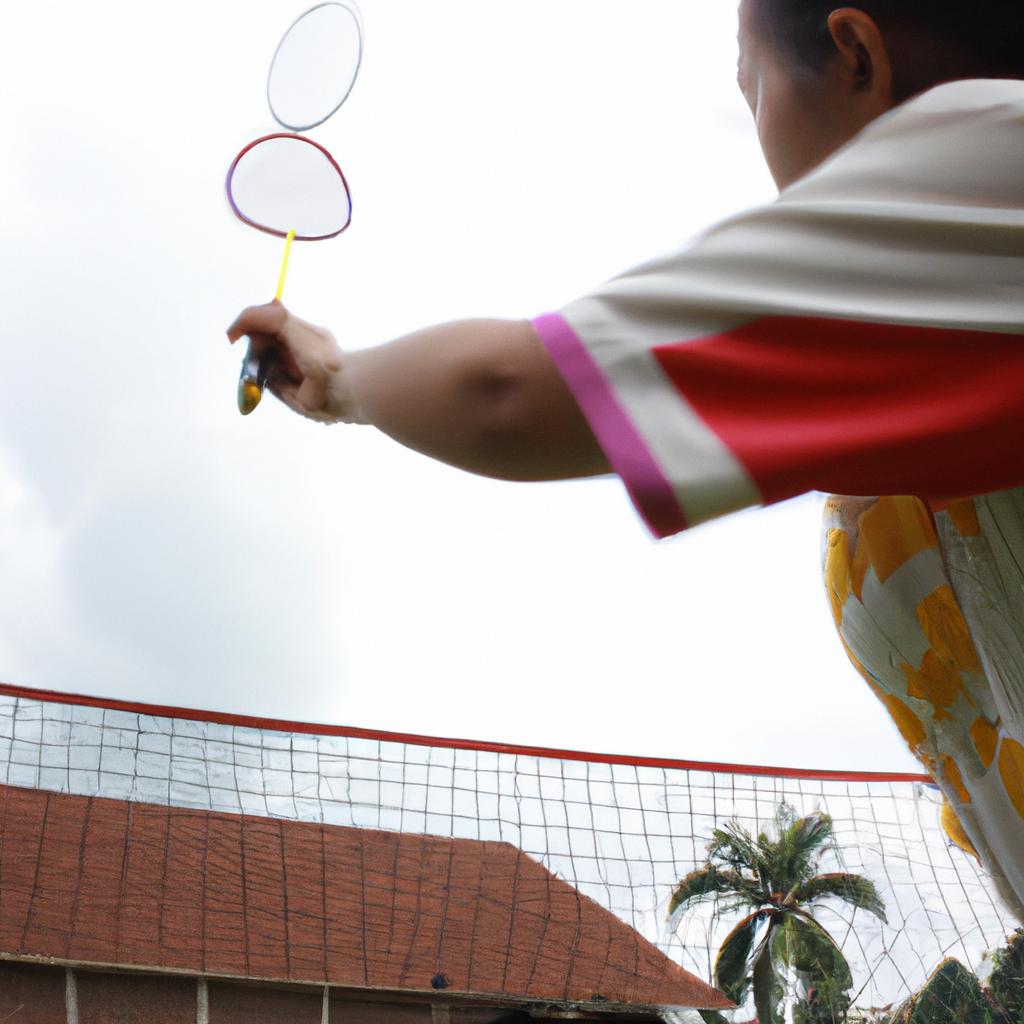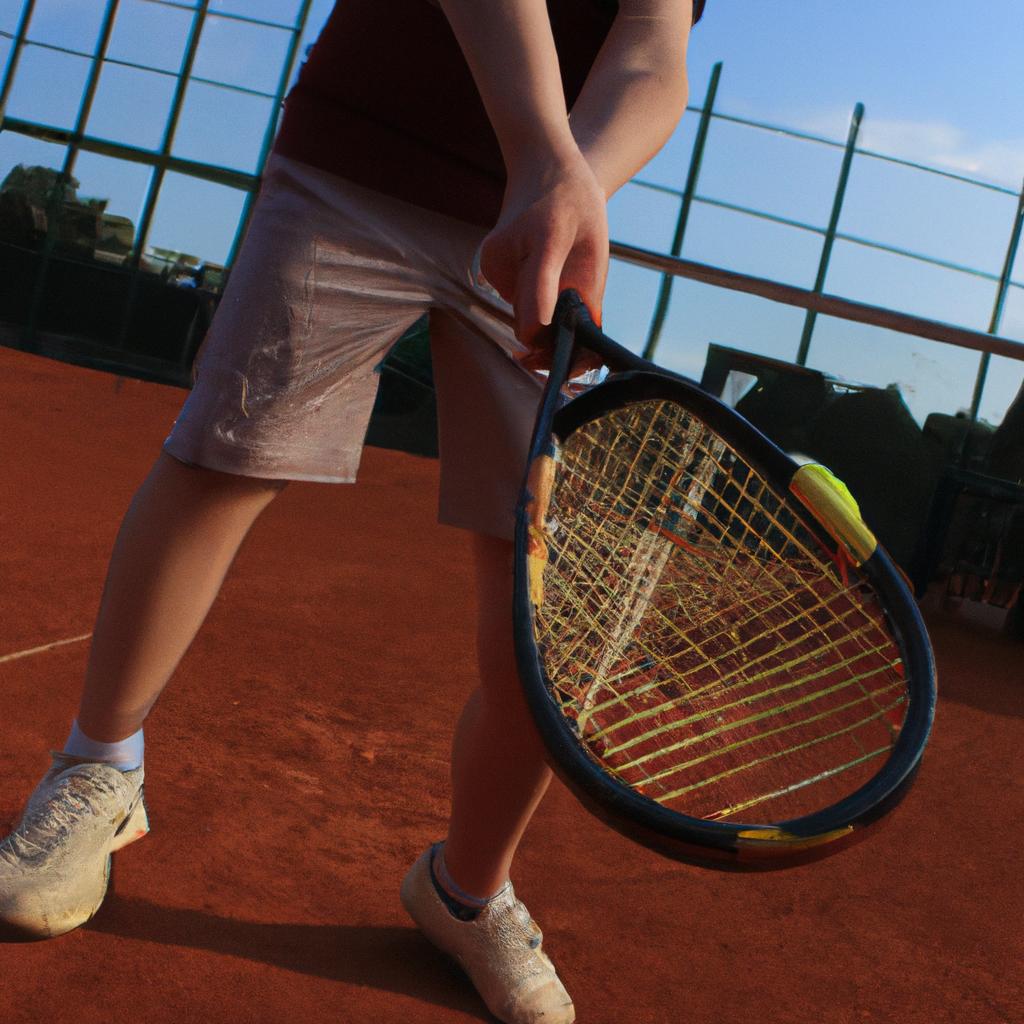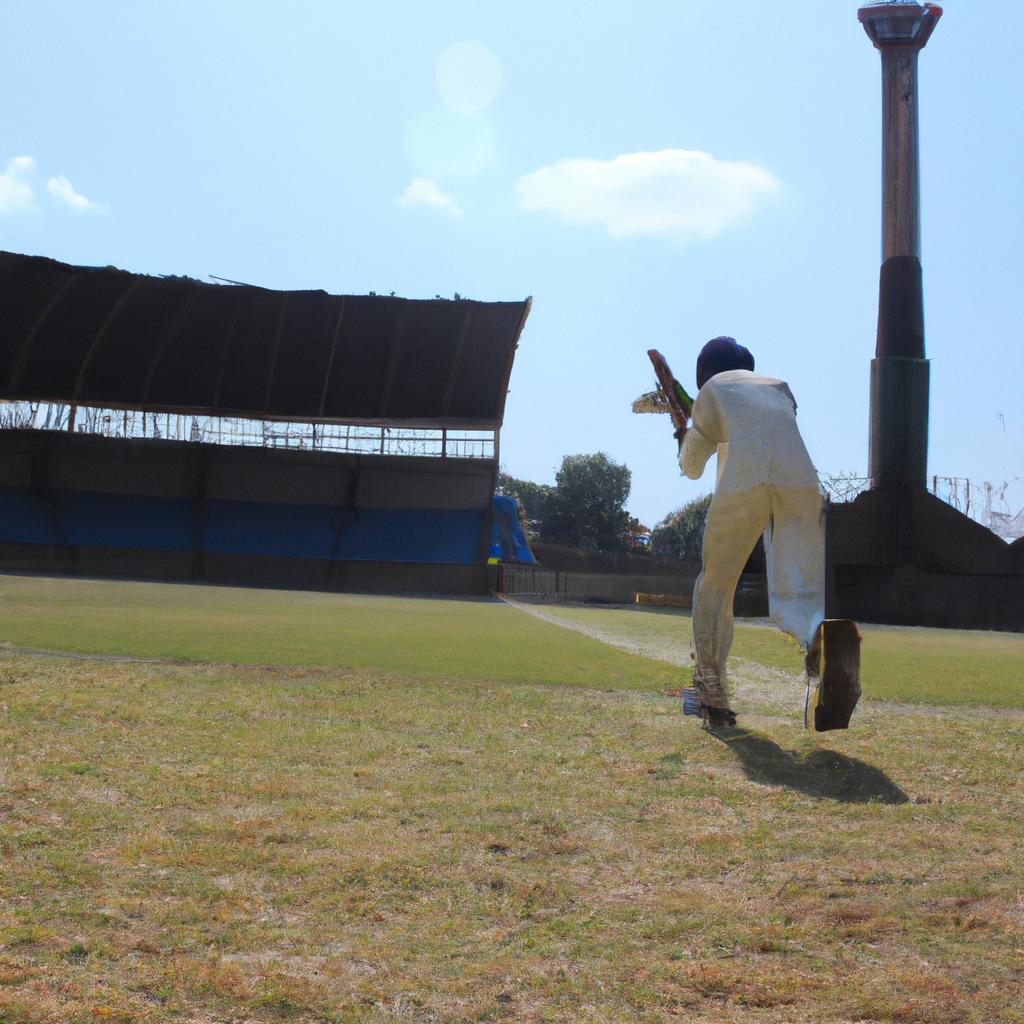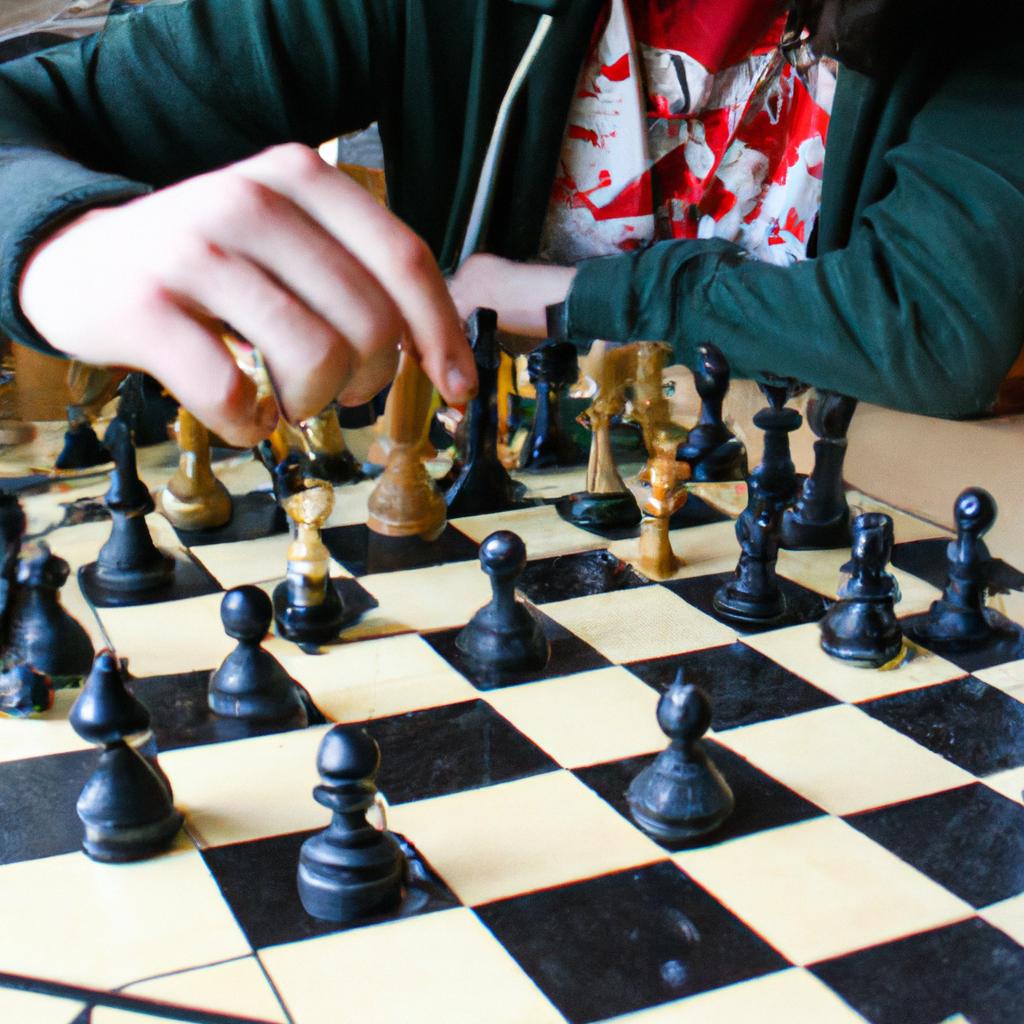Badminton is a popular sport that has gained significant attention in recent years due to its fast-paced and dynamic nature. This comprehensive guide aims to provide an in-depth exploration of the game, delving into its history, rules, techniques, and strategies. By examining the intricacies of badminton, this article seeks to equip readers with a thorough understanding of the sport and enable them to engage more effectively on both recreational and competitive levels.
Imagine a scenario where two players are engaged in an intense badminton match: their swift movements across the court, strategic shots aimed at outwitting their opponent, and precise execution showcasing their skill level. Such scenarios embody the essence of badminton as it encompasses agility, speed, power, precision, and mental acuity. Originating from ancient civilizations thousands of years ago and evolving into a widely played modern-day sport, badminton offers numerous physical health benefits while fostering social interaction and friendly competition.
This article will commence by tracing the historical roots of badminton before shifting focus towards elucidating the fundamental rules governing gameplay. Subsequently, key techniques such as grip styles, footwork patterns, shot selection variations will be explored in detail along with tactical considerations for different game formats including singles and doubles matches.
Overview of the Game
Imagine yourself on a sunny afternoon, surrounded by the rhythmic thwacks and swift movements of athletes engaged in an intense game. One such game that captivates players and spectators alike is badminton. Originating from ancient civilizations, this sport has evolved into a highly competitive activity enjoyed worldwide.
To provide you with a comprehensive understanding of badminton, we will explore its key features and rules. Firstly, let’s delve into the fundamental equipment required to play the game. Players utilize lightweight rackets made of carbon fiber or other durable materials to strike a shuttlecock back and forth over a net. The shuttlecock, also known as the birdie or shuttle, consists of feathers attached to a cork base. Its unique aerodynamic design allows for precise control during gameplay.
In order to succeed in badminton, players must possess certain essential skills. These include agility, speed, coordination, and strategy. A player’s ability to swiftly move around the court while maintaining balance impacts their overall performance significantly. Furthermore, mastering various strokes like clears, smashes, drops, and drives enables players to outmaneuver opponents effectively.
The emotional response evoked by these points can be one of excitement and anticipation:
- Agility: Experience the thrill of darting across the court with lightning-fast reflexes.
- Speed: Feel your heart race as you sprint towards victory.
- Coordination: Sense the satisfaction when every movement aligns perfectly.
- Strategy: Embrace the strategic challenge of planning each shot strategically.
| Skills | Description |
|---|---|
| Agility | Swiftly maneuver around opponents |
| Speed | Move quickly across the court |
| Coordination | Harmonize body movements for precision |
| Strategy | Strategically plan shots to gain an advantage |
Now that we have explored basic concepts related to badminton — its equipment and essential skills — we can proceed to delve further into the importance of skill development. By honing these abilities, players enhance their chances of success on the court and elevate their overall gameplay experience.
As a transition into the subsequent section:
Understanding the significance of skill development in badminton is crucial for aspiring athletes seeking to improve their performance. Let us now explore how this aspect plays an integral role in advancing one’s proficiency in the game.
Importance of Skill Development
Transitioning from the previous section, where we gained an overview of the game of badminton, let us now explore the significance of skill development in this sport. To illustrate this point, consider the case of a novice player who lacks proper technique and strategic knowledge. Despite having decent physical fitness, they struggle to control their shots and make effective decisions during gameplay. This example highlights how essential it is for players to develop their skills in order to excel in badminton.
Skill development plays a crucial role in enabling players to enhance their performance on the court. Here are some key reasons why focusing on skill development is imperative:
- Improved Technique: Developing proper techniques allows players to execute shots accurately and with precision. Mastering fundamental strokes such as clears, smashes, drops, and net shots empowers players to effectively respond to different game situations.
- Enhanced Physical Fitness: Engaging in regular training sessions aids in building stamina, strength, agility, and flexibility – all vital components of successful badminton play. Improving these aspects contributes not only to better overall performance but also reduces the risk of injuries.
- Strategic Thinking: Skill development involves understanding various strategies employed in different playing styles and scenarios. Players who invest time honing their skills gain a deeper understanding of tactical approaches like shot placement, court positioning, and anticipating opponents’ moves.
- Mental Resilience: Acquiring advanced skills instills confidence within players while boosting mental resilience. The ability to stay calm under pressure enables them to make quick decisions during intense rallies without succumbing to stress or panic.
To emphasize the importance of skill development further, let’s take a look at the following table showcasing notable attributes that can be nurtured through focused practice:
| Attribute | Description |
|---|---|
| Precision | Executing accurate shots consistently |
| Quick Reflexes | Reacting swiftly to opponent movements |
| Footwork | Maintaining proper movement on the court |
| Shot Variety | Employing a wide range of shots to keep opponents guessing |
As we can see, skill development encompasses various aspects that contribute to an overall improvement in performance. By dedicating time and effort to developing these skills, players lay a strong foundation for their journey towards becoming proficient badminton athletes.
Understanding the importance of skill development sets the stage for exploring different levels of competition within the sport. Now let’s delve into how players progress from casual play to more competitive arenas without compromising their growth as badminton enthusiasts.
Different Levels of Competitions
Moving forward from the importance of skill development, let us now explore the Different Levels of Competitions in badminton.
Different Levels of Competitions
To illustrate the varying degrees of competition in badminton, consider the following hypothetical scenario: Sarah, an aspiring badminton player, starts her journey by participating in local tournaments. These events are usually organized at community centers or nearby clubs and attract players from within a specific region. Local competitions provide an excellent platform for beginners to gain experience and test their skills against other players at a similar level.
As players progress and improve their game, they often aim to compete at regional or national championships. Regional competitions bring together participants from various cities or states, showcasing talent on a larger scale. National tournaments serve as platforms where exceptional players showcase their abilities and vie for recognition at a broader level.
The pinnacle of competitive badminton lies in international tournaments such as the Olympic Games or prestigious championships like the BWF World Championships. These events gather world-class athletes who have dedicated years to refining their skills and reaching peak performance. International competitions not only require exceptional physical prowess but also demand mental strength, strategic planning, and adaptability.
Let’s take a moment to appreciate the emotional rollercoaster that these different levels of competition can evoke:
- The excitement before stepping onto the court for your first local tournament.
- The nerve-wracking feeling when facing tough opponents during regional championships.
- The pride and sense of accomplishment representing your nation on an international stage.
- The joyous celebration upon achieving victory after months (or even years) of hard work.
Table: Emotions Experienced Across Competition Levels
| Competition Level | Emotions |
|---|---|
| Local Tournaments | Excitement |
| Regional Championships | Nervousness |
| International Events | Pride |
In summary, badminton offers various levels of competition catering to players’ aspirations and abilities. From local tournaments to international events, each level presents its own unique challenges and emotions. As we delve further into the evolution of badminton rules, let’s explore how these competitions have shaped the game over time.
Moving forward from our exploration of different competition levels, let us now delve into the evolution of badminton rules.
Evolution of Badminton Rules
In the ever-evolving world of sports, badminton has not been immune to changes in its rules and regulations. Over time, various modifications have been made to enhance the game’s competitiveness and ensure fair play. One notable example is the introduction of rally scoring, which revolutionized how points are awarded during a match.
Rally scoring was first implemented in competitive badminton during the late 1990s. Unlike traditional scoring systems where only the serving team could score points, rally scoring allows both teams to earn points regardless of who serves. This change increased the intensity of each rally as players had to work harder for every point, resulting in more exhilarating matches for spectators and heightened pressure on athletes.
The evolution of badminton rules can be further understood through a brief exploration of key changes that have shaped the game:
- Introduction of standardized court dimensions.
- Adoption of feather shuttlecocks instead of wooden ones.
- Implementation of umpire challenges using video replay.
- Restriction on service height to eliminate excessive flicking.
These alterations aimed at improving fairness, safety, and overall enjoyment for players and audiences alike. By adhering to consistent court dimensions worldwide, it ensures that all players face similar challenges regardless of location. Switching from wooden shuttlecocks to feathers improved flight characteristics and added finesse to shots. Introducing video replays for umpire decisions brought an element of transparency into crucial moments while minimizing human error. Finally, imposing restrictions on service height curtailed overuse of powerful flick serves that were deemed unfair by some players.
As we delve deeper into understanding the intricacies surrounding badminton’s rulebook, let us now explore one aspect that goes hand-in-hand with these developments – famous badminton players who have left an indelible mark on this sport’s history.
Famous Badminton Players
Building upon the evolution of badminton rules, it is crucial to explore the impact that famous badminton players have had on the sport. By examining their exceptional skills and achievements, we can gain valuable insights into how this game has shaped over time.
One notable example of a legendary badminton player is Lin Dan from China. With his extraordinary agility and powerful smashes, Lin Dan has won numerous titles throughout his career, including two Olympic gold medals in 2008 and 2012. His ability to strategically outmaneuver opponents on the court demonstrates not only his physical prowess but also his mental acuity.
To further understand the significance of these exceptional athletes’ contributions to badminton, consider the following:
- Dedication: Famous badminton players exhibit an unwavering commitment to training and honing their skills, often investing countless hours into practice sessions.
- Perseverance: Overcoming setbacks and injuries is a common theme among top performers in any sport. These players demonstrate remarkable resilience and determination in bouncing back from challenges.
- Sportsmanship: Respected figures in badminton embody good sportsmanship by displaying fair play, respect for opponents, and grace both on and off the court.
- Inspiring Role Models: Through their accomplishments, famous players inspire aspiring athletes around the world to pursue excellence in badminton or any other endeavor they are passionate about.
Table – Achievements of Selected Famous Badminton Players
| Player | Nationality | Major Titles Won |
|---|---|---|
| Lin Dan | China | 5 World Championships |
| Carolina Marin | Spain | 3 World Championships |
| Lee Chong Wei | Malaysia | 69 Career Titles |
| Saina Nehwal | India | Bronze Medal at Olympics (2012) |
By understanding the journey and accomplishments of famous badminton players, we gain insights into their dedication, perseverance, sportsmanship, and their ability to serve as inspiring role models. As we delve deeper into this comprehensive guide on badminton, let us now explore the strategies and techniques that can elevate one’s game to new heights.
With a foundation built upon the evolution of rules and an appreciation for iconic players’ contributions, it is time to delve into the world of strategies and techniques in badminton.
Strategies and Techniques
Section 2: Strategies and Techniques
Building upon the knowledge of famous badminton players, this section delves into the strategies and techniques employed by skilled athletes in the game. By understanding these tactics, players can enhance their performance on the court.
One effective strategy is to utilize deceptive shots. This involves disguising your intentions during play to catch opponents off guard. For instance, imagine a player executing a powerful overhead smash but instead lightly taps the shuttlecock over the net at the last moment, leaving their opponent unprepared and unable to return it effectively.
To improve one’s overall gameplay, mastering different shot techniques is crucial. These shots include smashes, clears, drops, and drives – each serving a unique purpose within specific situations during matches. A well-rounded player should be proficient in executing all four types of shots with precision and accuracy.
In addition to technique, footwork plays an essential role in successful gameplay. Agility and quickness allow players to swiftly navigate around the court while maintaining balance and positioning themselves optimally for every shot. Efficient footwork enables players to cover more ground efficiently and react swiftly to incoming shots from their opponents.
Strategies such as deception shots, along with mastery of various shot techniques and agile footwork, are vital components of achieving success in badminton. Implementing these skills not only enhances one’s chances of winning matches but also adds excitement and unpredictability to the game.
Emphasizing these key points:
- Deceptive shots can surprise opponents.
- Shot techniques like smashes, clears, drops, and drives serve distinct purposes.
- Agile footwork allows for better court coverage.
| Key Points |
|---|
| – Deceptive Shots |
| – Shot Techniques |
| – Agile Footwork |
Now that we have explored strategies and techniques used by top badminton players let us move on to understanding Equipment and Court Layout which form an integral part of playing this exhilarating sport.
Equipment and Court Layout
In the previous section, we explored various strategies and techniques employed in the game of badminton to gain a competitive edge. Now, let’s delve into another crucial aspect of the sport – equipment and court layout.
To illustrate the importance of proper equipment, consider this hypothetical scenario: Imagine two players with identical skills competing against each other. However, one player has access to high-quality rackets while the other uses an old, worn-out racket. It is evident that the former would have a significant advantage over their opponent due to better control, power, and maneuverability.
When it comes to playing badminton, having suitable equipment can make all the difference. Here are some key aspects to consider:
-
Racket selection: The choice of racket depends on factors such as weight distribution, flexibility, and grip size. Players need to find a racket that suits their style of play.
- Lightweight rackets allow for quicker shots and increased agility.
- Stiffer rackets provide more power but may sacrifice control.
- Selecting an appropriate grip size ensures comfortable handling during gameplay.
-
Shuttlecocks: These feathered projectiles come in different speeds – slow (green label), medium (blue label), and fast (red label). The speed determines how far they travel when hit. Choosing the right shuttlecock enables players to adapt their strategy accordingly.
Now let’s turn our attention toward court layout. A standard badminton court measures 13.4 meters long by 6.1 meters wide for singles matches and 13.4 meters long by 9.1 meters wide for doubles matches. The net divides the court into two halves vertically.
Consider these essential elements of a badminton court:
| Element | Dimensions |
|---|---|
| Net Height | 1.55 meters |
| Net Width | Extends across entire court |
| Boundary Lines | Clearly marked on the floor |
| Service Courts | Divided by center line |
Understanding the equipment required and being familiar with the layout of a badminton court are fundamental to playing the game effectively. By optimizing these aspects, players can enhance their performance and elevate their overall gameplay experience.
Transitioning into the subsequent section about “Development of Badminton as a Sport,” we will now explore how this beloved game has evolved over time, shaping its current status in global sports culture.
Development of Badminton as a Sport
Having explored the equipment and court layout in detail, it is now essential to understand the development of badminton as a sport. To exemplify this, let’s consider the case study of a group of individuals who started playing badminton regularly for six months. These individuals consisted of varying age groups and fitness levels.
The first noticeable impact was improved cardiovascular fitness among all participants. The dynamic nature of badminton requires constant movement and rapid changes in direction, leading to increased heart rate, improved blood circulation, and enhanced endurance. Additionally, engaging in regular badminton sessions helped lower resting heart rates and reduce the risk of developing cardiovascular diseases.
Furthermore, participation in badminton had a significant effect on muscular strength and power. The explosive movements involved in executing powerful smashes or quick lunges across the court engage multiple muscle groups simultaneously. Over time, consistent practice led to increased muscle mass, particularly in the legs, arms, shoulders, and core muscles. This improvement translated into better overall body strength and stability.
Additionally, coordination and agility were greatly enhanced through playing badminton regularly. The precise footwork required to reach shots quickly combined with hand-eye coordination when hitting the shuttlecock resulted in improved motor skills. Participants developed sharper reflexes and heightened spatial awareness during gameplay.
In conclusion,
The Impact of Badminton on Physical Fitness
Playing badminton regularly has numerous benefits beyond just being an enjoyable pastime. It positively impacts physical fitness by improving cardiovascular health, increasing muscular strength and power, enhancing coordination and agility.
Impact of Badminton on Physical Fitness
The development of badminton as a sport has been marked by significant milestones and the evolution of its rules and regulations. One such milestone was the establishment of the International Badminton Federation (now known as the Badminton World Federation) in 1934, which played a pivotal role in promoting and governing the sport on a global scale.
To better understand the impact of this development, let us consider an example: Sarah, a young athlete with a passion for racket sports, discovered badminton during her high school physical education class. Intrigued by its fast-paced nature and agility demands, she decided to join her school’s badminton team. Under the guidance of experienced coaches and regular practice sessions, Sarah gradually honed her skills, eventually competing at both national and international levels.
Sarah’s journey exemplifies how badminton has become increasingly popular worldwide due to several factors:
- Accessibility: Unlike many other sports that require expensive equipment or specialized facilities, badminton can be played almost anywhere with just a racket, shuttlecock, and net. This accessibility makes it easy for people from diverse backgrounds to engage in the sport without any major barriers.
- Health Benefits: Engaging in badminton offers numerous health benefits such as cardiovascular endurance, improved reflexes, enhanced coordination, strengthened muscles, and increased flexibility. These advantages make it an ideal choice for individuals seeking an enjoyable way to maintain their physical fitness.
- Social Engagement: Whether playing singles or doubles matches, badminton provides opportunities for social interaction and teamwork. Participating in tournaments or joining local clubs allows players to connect with like-minded individuals who share their enthusiasm for the game.
- Competitive Spirit: The competitive aspect of badminton fosters discipline, determination, and strategic thinking among players. Competing against opponents challenges athletes mentally and physically while pushing them to constantly improve their skills.
To further illustrate the Development of Badminton, let us take a closer look at the following table showcasing some key milestones in its history:
| Year | Milestone |
|---|---|
| 1873 | The game was introduced to England. |
| 1934 | Formation of International Badminton Federation. |
| 1992 | Badminton became an Olympic sport. |
| 2006 | Introduction of new scoring system (rally point). |
As can be seen from this table, badminton has come a long way since its inception and continues to evolve as a globally recognized sport.
In conclusion, the development of badminton as a sport has been driven by various factors such as accessibility, health benefits, social engagement, and competitive spirit. Through organizations like the International Badminton Federation and significant milestones in its history, badminton has gained popularity worldwide. As individuals like Sarah continue to embrace the sport’s challenges and rewards, it is clear that badminton will remain an integral part of games and sports for years to come.

